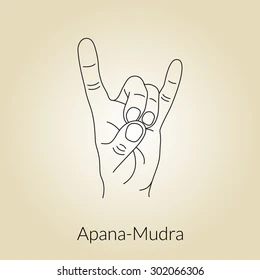Mudras. They are somewhat fanciful stuff. In the contemporary yoga world, not many of us have a complete understanding of what they actually are.
Hand movements known as mudras. The word mudra means "seal" in English. Seals are mudras. They are active ones, and it is thought that they can help with a variety of medical conditions.
We'll examine the top mudras for digestion in this article. Since yoga and Ayurvedic medicine hold that the health of the digestive tract is intimately connected to the health of the entire system, having a properly flowing digestive system was crucial to the ancient yogis.
The greatest mudras for balancing and improving digestive health are listed below.
1. Pushan Mudra
The mother of all mudras related to digestion and egress is the pushan mudra. On this list, it is the only mudra in which each hand is in a unique position. In the pushan mudra, the left hand assumes the shape of a mudra that represents elimination while the right hand relaxes in a position of receptivity.
The elimination organs are thought to be associated with this particular hand motion. Consider your stomach, liver, and gallbladder. The early yogis thought that when the hands were in the pushan mudra, numerous energies were sparked. They are manifestations of:
- Receptivity Digestive
- Assimilative processes
- Elimination.
- Avayu Prana (receptivity energy)
- The sama vayu (digestion and assimilation energies)
- Pana Vayu (the elimination energy)
- Cross your legs in a relaxed sitting position, such as the lotus pose (padmasana) or the easy pose (sukhasana).
- With the palms facing up, gently place both hands on the thighs. Relax the shoulders and the arms.
- Heighten the spine. Breathe in deeply.
- Stretch your pinky and ring fingers out with your right hand while bringing the tips of your thumb, forefinger, and middle finger together.
- Stretch the thumb, middle, and ring fingers with your left hand while bringing the tips of the pointer and pinky fingers together.
- Find a comfortable place to meditate, then inhale deeply to relax.
- Stretch the middle and pointer fingers while pressing the tips of the ring, little, and thumb together. Your left and right hands will both resemble this.
- If you're standing or lying down, place your hands by your sides or on your knees if you're seated.
- Take five to ten minutes to breathe deeply here while holding the prana mudra.
- Take a few deep breaths to centre yourself and find a peaceful seat to meditate in.
- Place your hands comfortably on your knees and touch your thumb with your middle and ring fingers.
- Keep your pinky and pointer fingers extended. Both the right and left hands will be in this position.
- Keep your eyes closed and sit quietly in apana mudra while taking deep breaths.




















No comments:
Post a Comment